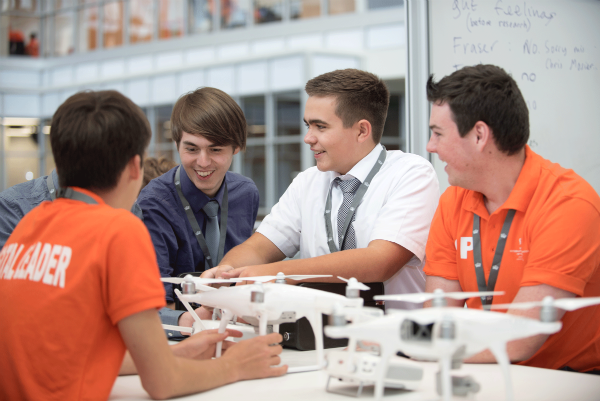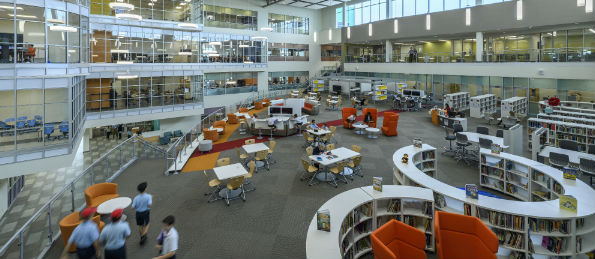How do we educate our students for their future? Should we imagine, design, build and open a brand new, state-of-the-art, school?
After all, how can we expect to develop learning to meet the needs of 21st-century learners when the buildings we work in still follow the same ‘industrial’ concepts we have used for years?
The usual concept for school buildings has traditionally been the classroom layout, each belonging to a teacher, all connected by corridors. Students move from room to room either based on their age or based on the subject they are being taught at that time. Rooms, furniture, and displays are usually fixed. This model matches the traditional, industrialized and standardized model for education that has been in place for many years. Rectangular boxes, joined by straight corridors are cheap and easy to build.
The real world does not work in isolation and we know that learners do not learn best in isolated classrooms. Connectivity is everywhere, and modern schools must be willing to adapt.
So, imagine being given the opportunity to be part of designing, building and opening a brand new, state-of-the-art, ‘school of the future.’
 Working with the Nord Anglia development team and lead architect, Ed Schmidt, that’s exactly what we did here in Houston. Our new 275,000 square foot campus opened this summer and our school now features an array of facilities and exciting learning areas that enriches and accommodates over 2000 students, spanning 34 acres.
Working with the Nord Anglia development team and lead architect, Ed Schmidt, that’s exactly what we did here in Houston. Our new 275,000 square foot campus opened this summer and our school now features an array of facilities and exciting learning areas that enriches and accommodates over 2000 students, spanning 34 acres.
The basic premise was quite simple. Instead of building a school around a standardized model of education and the requirements of teachers and teaching, what happens if you build it around the varied and personal needs of learners and their learning? Of course, several people had already been working on similar ideas, and I am grateful to everyone who has presented at conferences on modern learning environments, and especially those who willingly shared their ideas with us as we crystalized our own thinking.
In David Thornburg’s book entitled, From the Campfire to the Holodeck: Creating Engaging and Powerful 21st-century Learning Environments, he talks about the need to create a balance in spaces such as caves, campfires, watering holes and mountain tops. Each has a particular learning function, from quiet reflection to research, discussion, collaboration, and presentation.
 Similarly, every area in our school purposefully has possibilities. The center of the building is the Agora, the Greek market place, where anyone can come to share ideas, research and collaborate. This is the heart of the building, from where you can see the whole school in motion. The glass allows visibility for all learning spaces and sometimes I just like to sit and observe.
Similarly, every area in our school purposefully has possibilities. The center of the building is the Agora, the Greek market place, where anyone can come to share ideas, research and collaborate. This is the heart of the building, from where you can see the whole school in motion. The glass allows visibility for all learning spaces and sometimes I just like to sit and observe.
At any time in the Agora you will see younger students reading, older students researching, a class being taught, teacher’s planning their lessons and a few parents chatting over a coffee – all at the same time.
You will also see several administrators working, since this has become the chosen ‘office space’ for the leadership team. It’s a great place to be found easily.
All learning spaces are variable and flexible. Teachers are not assigned to a specific room. Instead, the campus is built in ‘neighborhoods’ to which teachers are assigned. Many teachers allow the students to design the learning environment most appropriate for their learning in that moment. This never ceases to amaze me because every time I walk around the building, the layout is different.
 In this school, learning is not something that is done to students. Instead, it is something that we empower our students to embrace and nurture, encouraging them to take responsibility for their individual growth on every level.
In this school, learning is not something that is done to students. Instead, it is something that we empower our students to embrace and nurture, encouraging them to take responsibility for their individual growth on every level.
Students in all year groups are highly engaged and move around the building with a high level of purpose and ownership of their own learning.
Many people inspired us on this highly-creative and collaborative journey. Alan November, author and international leader in education technology often points out the importance of connecting our students with the ‘best in the world’. Our Performing Arts Center and the curriculum were created in collaboration with The Juilliard School. The Maker Spaces and Design Thinking curriculum were designed in partnership with MIT and the robotics curriculum is in partnership with the First Lego. All of which ensure that students are constantly connected with the real world.
This project has surpassed our expectations in many areas. We learned so much from our colleagues around the world and from visiting other schools, so we would like to warmly invite anyone who is in the area to come and take a look. We never get tired of showing people around.
I give full credit to our staff. They have been incredibly open minded, hardworking and willing to try new ideas. This transition could have been very tough without such a team and they deserve a great deal of the credit. We need to study the impact in more detail, but we believe it has a lot to do with the fact that the entire building is built for learners; it is their school.
Andrew Derry is a Principal at the British International School of Houston and has worked in international education for more than 26 years. One of the things he has enjoyed the most has been the rich, diverse and rewarding discussions with colleagues around the world. One of the common themes in recent years has been, how do we educate our students for their future? What do you think? Tell us what you think in the comments section below.

